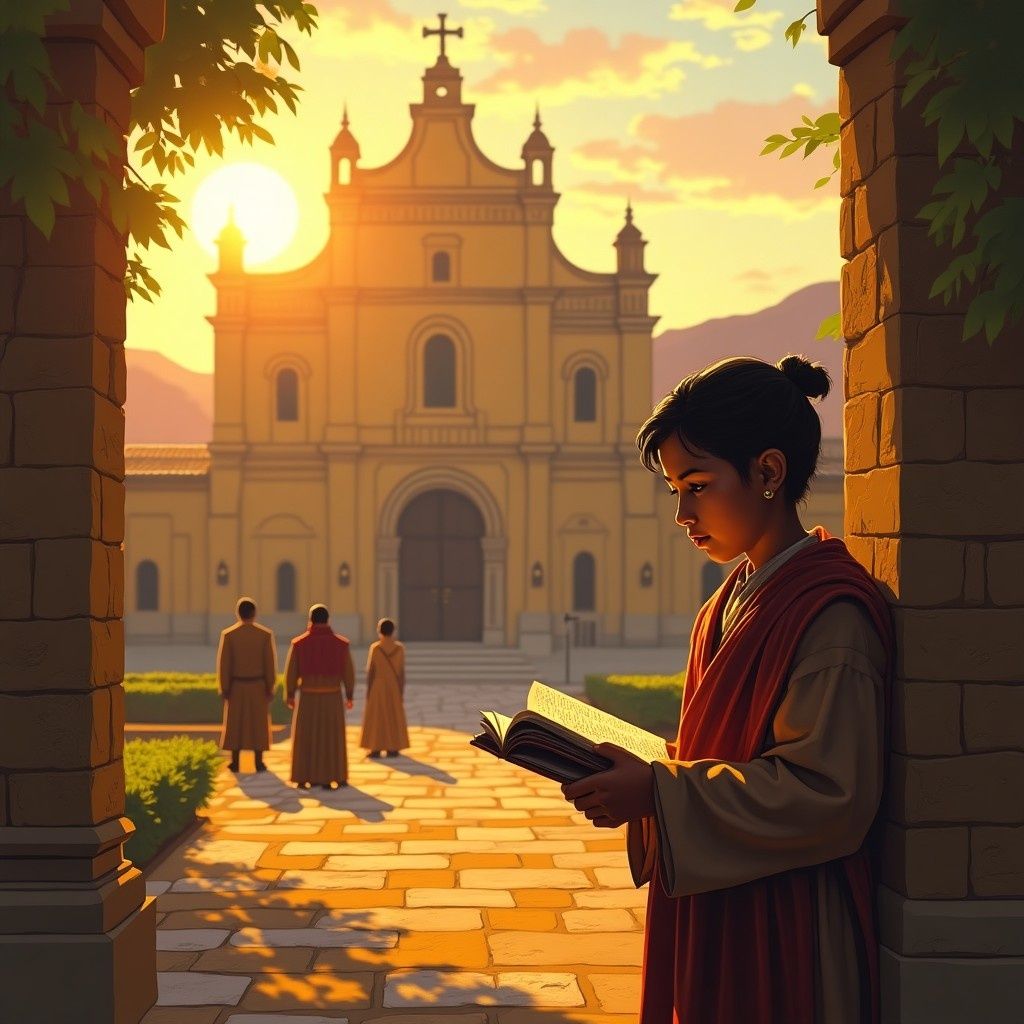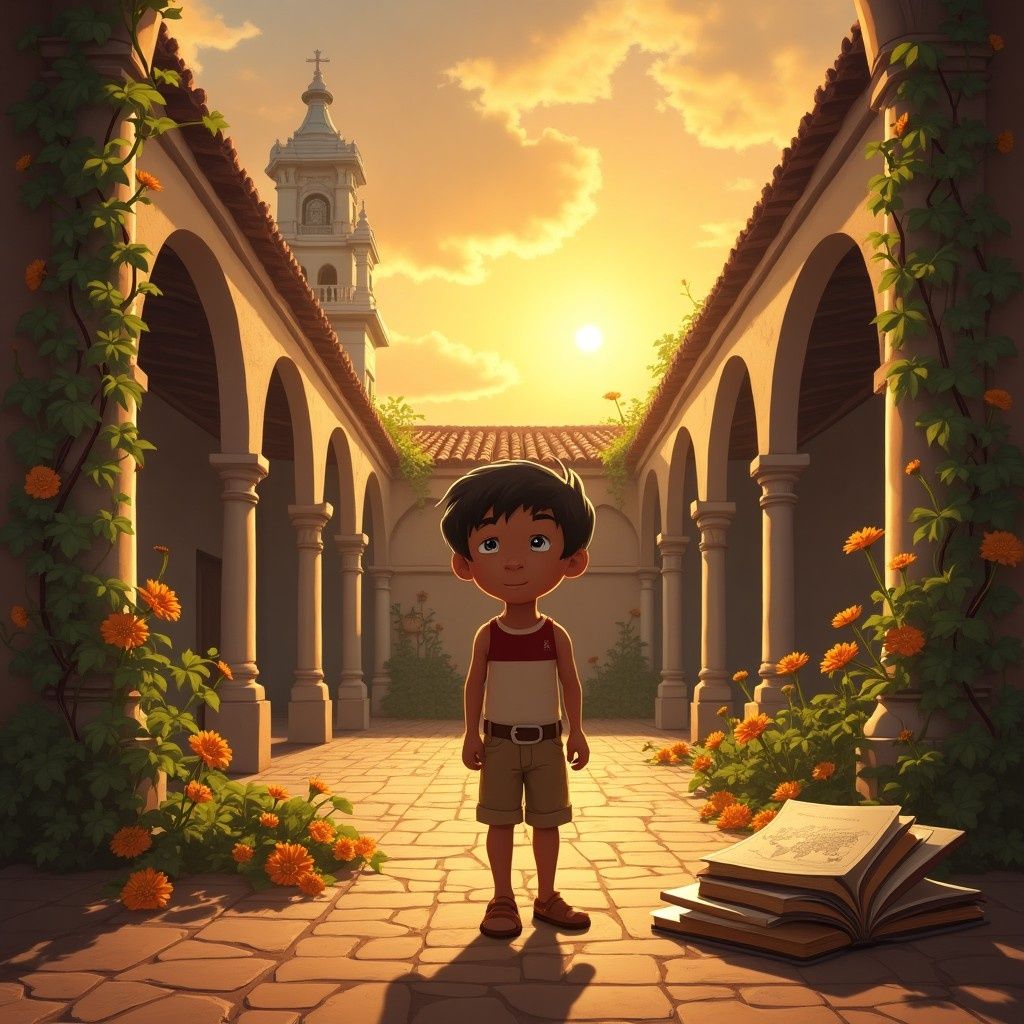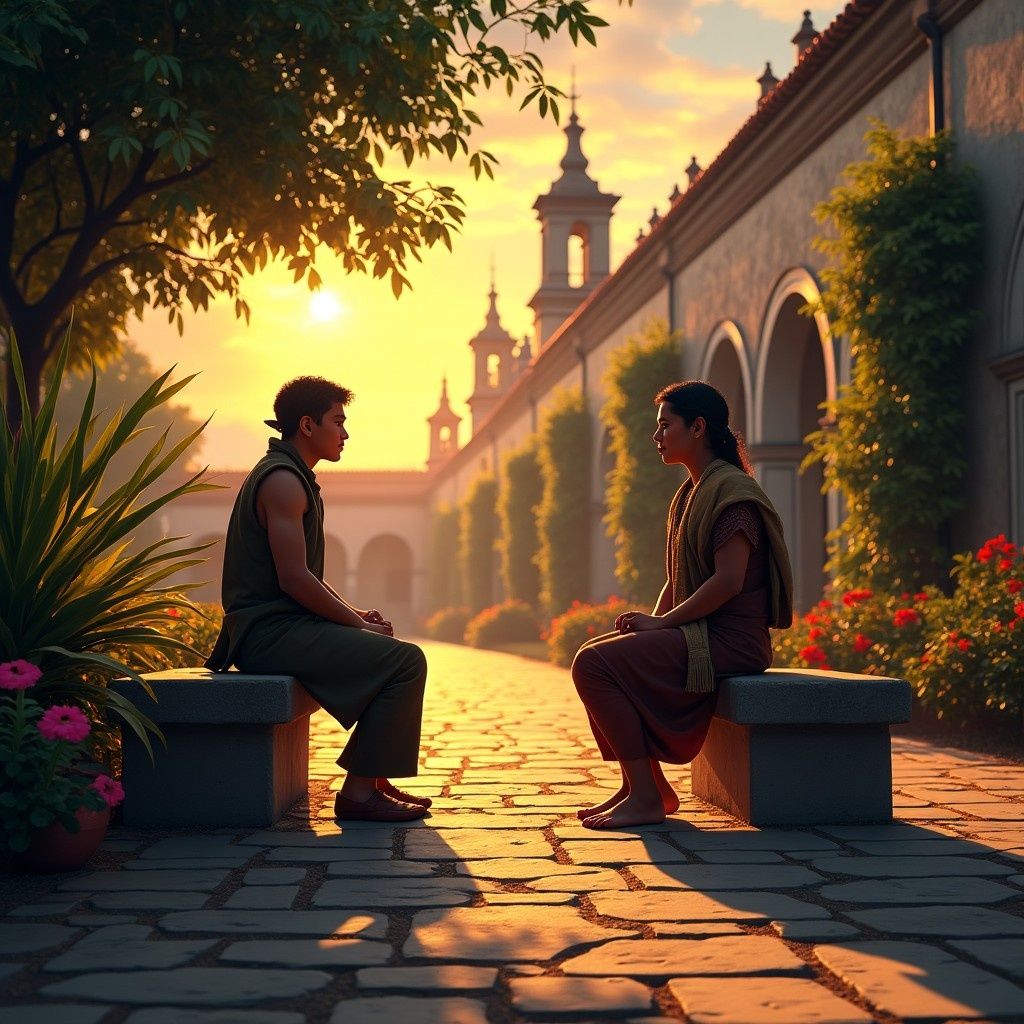In the heart of Tlatelolco, where the sun kissed the earth with a golden hue, the Colegio de Santa Cruz stood as a beacon of hope and ambition.

The year was 1536, and the air was thick with the scent of new beginnings. The Franciscans, with their humble robes and fervent dreams, had established the first European higher learning institution in the Americas. It was a place where young Native American boys, chosen for their keen minds and open hearts, were groomed for the Catholic priesthood. Among these boys was Xochitl, a young Nahua with eyes as bright as the morning star. He was known for his quick wit and a heart that pulsed with the rhythm of his ancestors. His father, a respected elder, had sent him to the Colegio with dreams of a future where their people would walk hand in hand with the newcomers, sharing wisdom and faith. Xochitl's days were filled with lessons in Latin, theology, and the arts of the European world. He was captivated by the stories of saints and the mysteries of the heavens, yet his heart yearned for the tales of his own people, the songs of the earth and sky that his grandmother whispered to him under the starlit nights.

Bishop Juan de Zumárraga, a man of vision and stern kindness, saw potential in Xochitl. He often spoke to him of a future where the Church would be enriched by the voices of the native clergy. "You, Xochitl, could be a bridge," he would say, his eyes alight with possibility. "A bridge between worlds." Yet, as the years passed, shadows crept into the halls of the Colegio. Financial strains tightened their grip, and whispers of a decree prohibiting indigenous ordination spread like wildfire. Viceroy Don Antonio de Mendoza, though a patron of the Colegio, found his hands tied by the edicts from afar. One evening, as the sun dipped below the horizon, casting long shadows across the courtyard, Xochitl sat with his friend, Mateo, another student whose spirit was as fiery as his own. They spoke in hushed tones, their voices mingling with the evening breeze. "Do you think they will ever let us become priests?" Mateo asked, his voice tinged with both hope and despair. Xochitl gazed at the fading light, his heart heavy with the weight of unspoken dreams. "I do not know, Mateo. But I do know that we carry something within us that no decree can take away." The day the decree was announced, a silence fell over the Colegio. The boys, once filled with dreams of priesthood, now faced an uncertain future. Xochitl felt a fire ignite within him, a determination to hold onto his identity, to be a voice for his people, even if not from the pulpit.

Years later, as an elder, Xochitl would stand before the remnants of the Colegio, now part of the Church of Santiago Tlatelolco. He would tell the story of a place where dreams were born and dashed, where hope flickered like a candle in the wind. He would speak of a time when young boys dared to dream of a world where they could be both Nahua and priests. Though the Colegio de Santa Cruz ultimately failed, its legacy lived on in the hearts of those who walked its halls. It was a testament to a dream that, while unfulfilled, sparked a fire that would never be extinguished. The site, now a cherished part of Mexico's cultural heritage, stood as a reminder of what could have been and what still might be. In the end, Xochitl's story was not one of defeat, but of resilience—a tale of a bridge not yet built, but whose foundations lay deep within the soul of a people who dared to dream.

The year was 1536, and the air was thick with the scent of new beginnings. The Franciscans, with their humble robes and fervent dreams, had established the first European higher learning institution in the Americas. It was a place where young Native American boys, chosen for their keen minds and open hearts, were groomed for the Catholic priesthood. Among these boys was Xochitl, a young Nahua with eyes as bright as the morning star. He was known for his quick wit and a heart that pulsed with the rhythm of his ancestors. His father, a respected elder, had sent him to the Colegio with dreams of a future where their people would walk hand in hand with the newcomers, sharing wisdom and faith. Xochitl's days were filled with lessons in Latin, theology, and the arts of the European world. He was captivated by the stories of saints and the mysteries of the heavens, yet his heart yearned for the tales of his own people, the songs of the earth and sky that his grandmother whispered to him under the starlit nights.

Bishop Juan de Zumárraga, a man of vision and stern kindness, saw potential in Xochitl. He often spoke to him of a future where the Church would be enriched by the voices of the native clergy. "You, Xochitl, could be a bridge," he would say, his eyes alight with possibility. "A bridge between worlds." Yet, as the years passed, shadows crept into the halls of the Colegio. Financial strains tightened their grip, and whispers of a decree prohibiting indigenous ordination spread like wildfire. Viceroy Don Antonio de Mendoza, though a patron of the Colegio, found his hands tied by the edicts from afar. One evening, as the sun dipped below the horizon, casting long shadows across the courtyard, Xochitl sat with his friend, Mateo, another student whose spirit was as fiery as his own. They spoke in hushed tones, their voices mingling with the evening breeze. "Do you think they will ever let us become priests?" Mateo asked, his voice tinged with both hope and despair. Xochitl gazed at the fading light, his heart heavy with the weight of unspoken dreams. "I do not know, Mateo. But I do know that we carry something within us that no decree can take away." The day the decree was announced, a silence fell over the Colegio. The boys, once filled with dreams of priesthood, now faced an uncertain future. Xochitl felt a fire ignite within him, a determination to hold onto his identity, to be a voice for his people, even if not from the pulpit.

Years later, as an elder, Xochitl would stand before the remnants of the Colegio, now part of the Church of Santiago Tlatelolco. He would tell the story of a place where dreams were born and dashed, where hope flickered like a candle in the wind. He would speak of a time when young boys dared to dream of a world where they could be both Nahua and priests. Though the Colegio de Santa Cruz ultimately failed, its legacy lived on in the hearts of those who walked its halls. It was a testament to a dream that, while unfulfilled, sparked a fire that would never be extinguished. The site, now a cherished part of Mexico's cultural heritage, stood as a reminder of what could have been and what still might be. In the end, Xochitl's story was not one of defeat, but of resilience—a tale of a bridge not yet built, but whose foundations lay deep within the soul of a people who dared to dream.
The Colegio de Santa Cruz in Tlatelolco, established by the Franciscans in 1536, was the first European higher learning institution in the Americas, aimed at educating Native American boys for the Catholic priesthood. Key figures involved in its founding included Bishop Juan de Zumárraga and Viceroy Don Antonio de Mendoza. Despite its initial promise and contributions to works like the Florentine Codex, the Colegio ultimately failed, largely due to financial difficulties and the prohibition of indigenous ordination by 1555. This failure had lasting implications, as it prevented the Mexican Church from developing a native clergy, which could have profoundly altered its history. Today, the site is remembered as part of Mexico's cultural heritage, with remnants visible at the Church of Santiago Tlatelolco.


Comments
Post a Comment